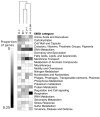The Bacterial Symbionts of Closely Related Hydrothermal Vent Snails With Distinct Geochemical Habitats Show Broad Similarity in Chemoautotrophic Gene Content
- PMID: 31474946
- PMCID: PMC6702916
- DOI: 10.3389/fmicb.2019.01818
The Bacterial Symbionts of Closely Related Hydrothermal Vent Snails With Distinct Geochemical Habitats Show Broad Similarity in Chemoautotrophic Gene Content
Abstract
Symbiosis has evolved between a diversity of invertebrate taxa and chemosynthetic bacterial lineages. At the broadest level, these symbioses share primary function: the bacterial symbionts use the energy harnessed from the oxidation of reduced chemicals to power the fixation of inorganic carbon and/or other nutrients, providing the bulk of host nutrition. However, it is unclear to what extent the ecological niche of the host species is influenced by differences in symbiont traits, particularly those involved in chemoautotrophic function and interaction with the geochemical environment. Hydrothermal vents in the Lau Basin (Tonga) are home to four morphologically and physiologically similar snail species from the sister genera Alviniconcha and Ifremeria. Here, we assembled nearly complete genomes from their symbionts to determine whether differences in chemoautotrophic capacity exist among these symbionts that could explain the observed distribution of these snail species into distinct geochemical habitats. Phylogenomic analyses confirmed that the symbionts have evolved from four distinct lineages in the classes γ-proteobacteria or Campylobacteria. The genomes differed with respect to genes related to motility, adhesion, secretion, and amino acid uptake or excretion, though were quite similar in chemoautotrophic function, with all four containing genes for carbon fixation, sulfur and hydrogen oxidation, and oxygen and nitrate respiration. This indicates that differences in the presence or absence of symbiont chemoautotrophic functions does not likely explain the observed geochemical habitat partitioning. Rather, differences in gene expression and regulation, biochemical differences among these chemoautotrophic pathways, and/or differences in host physiology could all influence the observed patterns of habitat partitioning.
Keywords: Alviniconcha; Campylobacteria; Gammaproteobacteria; Ifremeria; chemosynthesis; gastropod; genomics; symbiosis.
Figures





Similar articles
-
Genome assembly of the chemosynthetic endosymbiont of the hydrothermal vent snail Alviniconcha adamantis from the Mariana Arc.G3 (Bethesda). 2022 Sep 30;12(10):jkac220. doi: 10.1093/g3journal/jkac220. G3 (Bethesda). 2022. PMID: 35997584 Free PMC article.
-
Endosymbionts of Metazoans Dwelling in the PACManus Hydrothermal Vent: Diversity and Potential Adaptive Features Revealed by Genome Analysis.Appl Environ Microbiol. 2020 Oct 15;86(21):e00815-20. doi: 10.1128/AEM.00815-20. Print 2020 Oct 15. Appl Environ Microbiol. 2020. PMID: 32859597 Free PMC article.
-
Physiological dynamics of chemosynthetic symbionts in hydrothermal vent snails.ISME J. 2020 Oct;14(10):2568-2579. doi: 10.1038/s41396-020-0707-2. Epub 2020 Jul 2. ISME J. 2020. PMID: 32616905 Free PMC article.
-
The metabolic demands of endosymbiotic chemoautotrophic metabolism on host physiological capacities.J Exp Biol. 2011 Jan 15;214(Pt 2):312-25. doi: 10.1242/jeb.049023. J Exp Biol. 2011. PMID: 21177951 Review.
-
The symbiotic 'all-rounders': Partnerships between marine animals and chemosynthetic nitrogen-fixing bacteria.Appl Environ Microbiol. 2021 Mar 1;87(5):e02129-20. doi: 10.1128/AEM.02129-20. Epub 2020 Dec 18. Appl Environ Microbiol. 2021. PMID: 33355107 Free PMC article. Review.
Cited by
-
Niche partitioning in the Rimicaris exoculata holobiont: the case of the first symbiotic Zetaproteobacteria.Microbiome. 2021 Apr 12;9(1):87. doi: 10.1186/s40168-021-01045-6. Microbiome. 2021. PMID: 33845886 Free PMC article.
-
Geography, not lifestyle, explains the population structure of free-living and host-associated deep-sea hydrothermal vent snail symbionts.Microbiome. 2023 May 16;11(1):106. doi: 10.1186/s40168-023-01493-2. Microbiome. 2023. PMID: 37189129 Free PMC article.
-
Horizontal transmission enables flexible associations with locally adapted symbiont strains in deep-sea hydrothermal vent symbioses.Proc Natl Acad Sci U S A. 2022 Apr 5;119(14):e2115608119. doi: 10.1073/pnas.2115608119. Epub 2022 Mar 29. Proc Natl Acad Sci U S A. 2022. PMID: 35349333 Free PMC article.
-
Methane formation driven by light and heat prior to the origin of life and beyond.Nat Commun. 2023 Aug 1;14(1):4364. doi: 10.1038/s41467-023-39917-0. Nat Commun. 2023. PMID: 37528079 Free PMC article.
-
Classical and computed tomographic anatomical analyses in a not-so-cryptic Alviniconcha species complex from hydrothermal vents in the SW Pacific.Front Zool. 2020 May 7;17:12. doi: 10.1186/s12983-020-00357-x. eCollection 2020. Front Zool. 2020. PMID: 32391066 Free PMC article.
References
-
- Beck B. L. A. (1991). Olgaconcha tufari n. gen. et n. sp. - a new mesogastropod (Gastropoda: Prosobranchia) from hydrothermal vents in the manus backarc basin (Bismarck Sea, Papua New Guinea). Ann. Naturhist. Mus. Wien. 92 277–287.
-
- Beinart R. A., Gartman A., Sanders J. G., Luther G. W., Girguis P. R. (2015). The uptake and excretion of partially oxidized sulfur expands the repertoire of energy resources metabolized by hydrothermal vent symbioses. Proc. R. Soc. B Biol. Sci. 282:20142811. 10.1098/rspb.2014.2811 - DOI - PMC - PubMed
LinkOut - more resources
Full Text Sources
Research Materials

